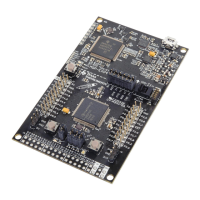Clocking
DCO: the Digitally Controlled Oscillator (DCO) provides a fast, low-lost, on-chip oscillator source.
It is very common to see this source being used to drive the CPU and many high-speed
peripherals. Another great feature is fast start-up time for this source, which is very important in a
low-power system (where you might want to sleep the clock to save power). Later in the chapter,
we'll explore a variety of methods for 'tuning' the DCO for improved accuracy.
MODOSC: the MODuale OSCillator (MODOSC) is another common high-frequency source. In
some devices, it dedicated to the Analog to Digital Converter (ADC) - which can start and stop the
source as needed. On other devices, though, the clock can be used to source a variety of
peripherals. In any case, this is another on-chip oscillator source.
Clock Details (by Device Family)
The MSP430F5529 specific clock options we just examined are found in the F5xx/F6xx UCS
(Unified Clock System) peripheral. As we’ve stated, various device sub-families provide different
clocking features and options. Each “unique” set of options is described by a clock peripheral
name – for example, while the ‘F5529 has the UCS peripheral, the ‘FR5969 Wolverine devices
use the CS peripheral.
MSP430 Clock Modules
Module Clock Module Name
MSP430
Device Family
BCS Basic Clock System F1xx / F2xx
BCS+
Basic Clock System +
F2xx / G2xx
FLL+ Frequency Locked Loop + F4xx
UCS Unified Clock System F5xx / F6xx
CS Clock System FR5xx
CCS Compact Clock System L092
In general, all of these “different” peripherals provide the same basic functionality: that is, they
nearly all provide three internal clocks (MCLK, SMCLK, ACLK) from a similar set of oscillator
sources.
What differs between them are exactly which sources are provided for a given family, how the
DCO frequency is configured and tuned, as well as a number of other miscellaneous clock
features. Many of these similarities and differences are described over the next few pages.
MSP430 Workshop - MSP430 Clocks & Initialization 4 - 11

